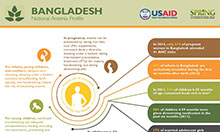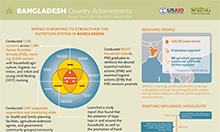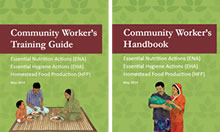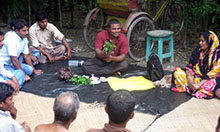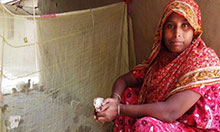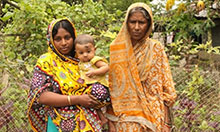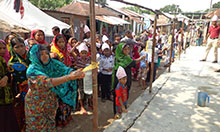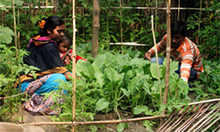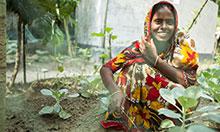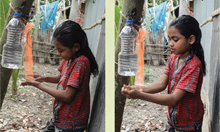Fiscal Years 2012-2017
Executive Summary

SPRING officially launched activities in Bangladesh in April 2012. Upon receiving letters of support from government Directorate Generals and securing a tripartite Memorandum of Understanding (MOU) from the National Nutrition Services (NNS) and the Revitalization of Community Health Care in Bangladesh (RCHCIB), both under the Ministry of Health and Family Welfare (MOHFW), the project moved forward quickly to identify health facilities and workers with which we could begin our work. The project also received support from the Ministry of Agriculture (MOA), which allowed us to work through the Department of Agricultural Extension and its many hundreds of frontline agricultural extension officers – at the time, a very innovative approach. SPRING used a first 1,000-days approach, looking at the critical window of a child's early development between the time a woman becomes pregnant and the child's second birthday. As such, children under two years of age, as well as pregnant and lactating women (PLW) were the primary target groups of the project. SPRING's partnership with the two Government of Bangladesh (GOB) ministries helped us reach millions of people through existing platforms and channels.
SPRING/Bangladesh implemented an innovative, scalable, and sustainable community-based, multi-channel, integrated nutrition program between April 2012 and June 2017. During this five-year period, the project reached more than 125,000 PLW and their children through its farmer nutrition schools (FNS) approach, and nearly 6,500 FNS were established over this period. Further, SPRING trained and provided supportive supervision to more than 4,000 frontline health staff from over 1,400 health facilities, as well as nearly 1,000 frontline agriculture staff. We also brought the GOB departments of family planning, health services, and agriculture extension together for the first time around the issue of community nutrition. Improved nutrition practices were sustained at the community level a year or more after the FNS work had finished, an indication of the long-term impact of our work. There was also strong evidence of spillover to non-beneficiaries in SPRING's working areas.
Through several applied research and evaluation studies carried out throughout the project as well as through our program monitoring data, we found that women's dietary diversity scores dramatically improved, and that women's empowerment levels rose quickly and remained higher than for non-FNS women. We also found that the quality of nutrition service delivery and frequency of supportive supervision visits among the GOB dramatically improved, that frontline GOB workers were better equipped to discuss and address nutrition issues, and that other underlying practices, such as handwashing, greatly improved.
SPRING implemented the project across many upazilas (sub-districts) along the southern coastal belt of Bangladesh, in Barisal and Khulna divisions, which falls within the Feed the Future (FTF) Zone of Influence. We started with 15 upazilas in 2012 and successfully scaled our activities to 40 upazilas by 2013, SPRING remained in these 40 upazilas to both deepen and widen coverage to as many in our target population as possible. By the time SPRING finished activities in 2017, we estimate that we reached 60 percent of the target population of PLW within the two poorest wealth quintiles.
SPRING in Bangladesh
Background
The prevalence of undernutrition in Bangladesh is among the highest in the world. When we first designed the SPRING program for Bangladesh in late 2011, nearly 50 percent of children under five years of age, and 30 percent of women of childbearing age were suffering from undernutrition, regardless of socio-economic status (Howlader and Ranjan 2012). Millions of children and women in Bangladesh suffer from one or more forms of malnutrition, including low birth weight, wasting, stunting, underweight, vitamin A deficiency, iodine deficiency disorders, and anemia, as well as increasing rates of obesity and related non-communicable diseases, such as diabetes.
Bangladesh has recorded some improvements in child nutritional status over the last decade, such as meeting its Millennium Development Goals to reduce the number of underweight children and reducing the prevalence of stunting in children under five years of age from 51 percent in 2004 to 41 percent in 2011 and to 36 percent in 2014. Despite these accomplishments, the rates of improvement are not consistent throughout all geographical areas and wealth quintiles, and there are still important areas of concern. For example, wasting among children under five years of age rose from 15 percent in 2004 to 16 percent in 2011, then fell only slightly to 14 percent in 2014 (NIPORT et al. 2016). In addition, exclusive breastfeeding rates remain low at only 55 percent, while the quality of diets among all people remains a concern.
Achieving meaningful change will require increased investment, innovation, and scaling-up of nutrition interventions, especially those focusing on women and children. Improved nutrition among women and young children is a high-level objective of both the USAID/Bangladesh's FTF and Global Health Initiative (GHI) strategies. These plans align with the GOB Health, Population and Nutrition Sector Development Program (HPNSDP), which aims to address nutritional needs of the most vulnerable families through the NNS operational plan. Reducing malnutrition is also one of the priorities of Bangladesh Vision 2021, and the GOB fourth five-year sector plan, which commences in July 2017.
SPRING Goals and Objectives
The goal of the SPRING/Bangladesh project was to improve the nutritional status of PLW and children under two years of age in Barisal and Khulna divisions. The SPRING team initiated activities in April 2012, and the project concluded in June 2017 after five years of implementation.
The project had four objectives:
Objective 1: Scale up the promotion and support of the essential nutrition actions and essential hygiene actions (ENA/EHA) within the MOHFW, MOA, and other health and agriculture projects in Barisal and Khulna divisions.
Objective 2: Enhance the capacity of frontline health and agriculture workers within the MOHFW and MOA and community workers and groups through training, supportive supervision, and community mobilization to deliver quality services and counseling on ENA/EHA for PLW and children under two years of age in Khulna and Barisal divisions.
Objective 3: Increase household access to, and utilization of, diversified foods using the FNS approach.
Objective 4: Enhance project learning and sharing.
Figure 1. SPRING/Bangladesh logic model
TIBF = timely introduction of breastfeeding; EBF = exclusive breastfeeding; TICF = timely introduction of complementary feeding; MAD = minimum acceptable diet.
Technical Approach
At the intersection of two U.S. government foreign assistance initiatives—FTF and the GHI—SPRING was aligned with the GOB National Nutrition Strategy and worked across multiple sectors, including health and agriculture. SPRING signed a tripartite MOU with the NNS and the RCHCIB project in 2012 as part of our effort to effectively advocate for and coordinate aspects of nutrition with the GOB.
SPRING's technical approach focused on promoting and supporting the adoption of ENA/EHA as well as the consumption of nutritious and diverse diets. Enabling and mobilizing individuals and communities to promote and adopt healthy behaviors, particularly in the context of nutrition, was at the center of our work. We dedicated ourselves to working with the GOB to reach the poorest and most vulnerable to malnutrition. In doing so, we advanced efforts to tackle one of the underlying causes of maternal and child morbidity and mortality.
We established a logic model to adapt our programmatic approaches to Bangladesh's specific context and needs (see Figure 1).
Interventions and Coverage
Between 2012-2017, the SPRING team achieved rapid and broad coverage across 40 upazilas in 9 districts in the 2 target divisions (see Figure 2 and Table 1), covering a population of 5.7 million people. SPRING started work in 15 upazilas in 2012 and expanded to 40 upazilas in 2013. The project intensified its coverage within these 40 upazilas in fiscal year (FY)14, FY15, and FY16, reaching many more communities and families. SPRING estimates that we reached approximately 60 percent of the PLW in the two poorest wealth quintiles living in these 40 upazilas over our five-year implementation period.
SPRING partnered with the NNS and the Community Clinics group under the MOHFW well as the Department of Agricultural Extension under the MOA. By targeting both the health and agriculture sector and by using multiple existing government channels, we made use of strategic partnerships and close involvement with the government to implement a multi-channel, integrated program that had both nutrition-specific and nutrition-sensitive interventions. We designed a program to tackle undernutrition in the first 1,000 days of life among poor, rural families using scalable, sustainable, and innovative approaches and through this supported nearly 1,100 community clinics (CC) and over 300 union health and family welfare centers. SPRING trained nearly 1,000 frontline agriculture extension workers and over 5,000 frontline health workers and their supervisors. Through the health system, we made 8.6 million contacts with PLW between FY12-FY17 focusing on ENA/EHA. Over this same period, we made over 1.3 million contacts with PLW through the SPRING-trained agriculture agents and nearly 1.5 million contacts through our FNS work.
Table 1. Project districts and upazilas
| District | Upazilas |
|---|---|
| Barisal | Agailjhara, Babuganj, Bakerganj, Banaripara, Gaurnadi, Wazirpur |
| Barguna | Bamna, Betagi |
| Patuakhali | Bauphal, Dumki, Mirzaganj, Patuakhali Sadar |
| Bhola | Bhola Sadar, Burhanuddin, Char Fasson, Daulatkhan, Lalmohan, Manpura, Tazumuddin |
| Khulna | Dighalia, Dumuria, Paikgachha, Phultala, Rupsha, Terokhada |
| Bagerhat | Bagerhat Sadar, Chitalmari, Fakirhat, Kachua, Mollahat, Morrelganj |
| Jessore | Abhaynagar, Bagherpara, Jhikargachha, Keshabpur, Jessore Sadar, Monirampur |
| Magura | Magura Sadar |
| Narail | Kalia, Narail Sadar |
Accomplishments
The SPRING project was established as an innovative, scalable, and sustainable project that worked hand-in-hand with all levels of the GOB, to mobilize communities for better nutrition. As mentioned earlier, we supported 1,095 CCs and 309 family planning facilities, known as Union Health Centers. These partnerships helped SPRING scale up its project, details of which can be seen in Figure 3.
Innovative
We demonstrated our innovative programming through a multi-sectoral approach that linked traditional nutrition activities with agricultural activities. These carefully designed agriculture-nutrition linkages helped bridge the gap between two traditionally separate fields and established ways to successfully design programming that built off the critical elements of both fields to improve nutrition outcomes. This was particularly innovative in the sense that nutrition had not been integrated into the agriculture sphere until this time.
Within the MOA, SPRING trained nearly 1,000 frontline and supervisory level staff from the Ministry's Department of Agricultural Extension, known as Sub-Assistant Agriculture Officers (SAAO). We improved the capacity of these staff members to understand and deliver key messages on nutrition through their extension work with existing farmer groups and courtyard sessions. Through this trained cadre of frontline workers, SPRING made more than 1.3 million contacts focusing on nutrition over our five-year implementation period (see Figure 4). Our efforts to integrate nutrition were not focused on just "tacking on" nutrition messages to other existing activities or messaging, but instead to carefully tailor and adapt the ENA and EHA in ways that fostered a natural integration with ongoing agriculture work. We accomplished this by developing a curriculum – our Community Worker Guide and Handbook – specifically designed for non-health frontline workers. Not only did this effort make good use of an existing government channel through which nutrition messages could be delivered, but it also helped the GOB's efforts to mainstream nutrition throughout the government system. Introducing nutrition through an agriculture lens helped provide a platform through which nutrition-specific and nutrition-sensitive discussions could occur, allowing for better collaboration and coordination among various government and non-government partners around nutrition.
SPRING's innovative FNS approach was another example of how we mobilized community members and made use of existing resources and structures to facilitate improved nutrition. SPRING merged proven interventions including the Farmer Field School methodology (where farmers learn by doing), the homestead food production (HFP) methodology (where people learn about nutrition-diversified home garden foods), ENA (which focuses on action-oriented messages during the first 1,000 days), and EHA (which embeds hygiene practices into nutrition and HFP activities) to create the FNS approach. The FNS approach provides an excellent platform for implementing both nutrition-specific and nutrition-sensitive activities, as it focuses on learning by doing and a discovery approach rather than using a hierarchical or classroom style setting. The FNS builds women's confidence, strengthens community bonds, promotes resilience, empowers women to take charge of their family's health and nutrition, strengthens ties to local health and agricultural workers, and demonstrates to other community members the power of small, doable actions.
One particularly important innovation within the development of the FNS was the establishment of community nutrition champions (CNC). A CNC is a voluntary position created in each of the FNS as well as in our 373 working unions in an effort to continue to promote and motivate people around nutrition after the end of the FNS. Community nutrition champions were selected from among their peers upon completion of the 18 FNS sessions. If the selected woman agreed, she was given a certificate as a token of everyone's appreciation and a lanyard to help her be identified in the community. When SPRING first explained this approach to the Community Clinic group, the former Additional Secretary of the MOHFW and Line Director of the Community Clinics, Dr. Makhduma Nargis, immediately took an interest. She circulated an official memo to all 14,000+ CCs in Bangladesh requesting that CNCs be allowed to join as co-opted members of the administrative groups, known as community groups or community support groups (CG/CSG). These groups help ensure the smooth running of CCs. (RCHCIB/GO-NGO Coordination – 03/2014/1683/1(8)). This support not only helped further mobilize these champions to take leadership roles in their communities, but also served as an important mechanism to strengthen ties between frontline health facilities and the women and children these facilities served. By the end of March 2017, nearly 1,500 of SPRING's CNCs were serving their communities as part of these administrative bodies. See Figure 5 for more details on the total number of CNCs compared to the number of CNCs involved in the CG/CSG.
Scalable
SPRING found three ways to make our work scalable in Bangladesh: strategic partnerships, cost effective programming, and implementation using small, doable actions and simple technologies. When SPRING was first asked by USAID to design a nutrition program in Bangladesh in December 2011, the local mission wanted a program to scale up and to reach as many people as possible as quickly as possible. SPRING took this challenge and designed an efficient and effective program to achieve this goal. We looked to existing, proven models that demonstrated impact and that were simple to teach, easy to do, and likely to be sustained. We also focused on existing networks, systems, and resources and tried to use as many available training tools as possible.
Figure 5. Total number of community nutrition champions (CNCs) and their participation in community groups or community support groups (CG/CSG)
SPRING utilized strategic partnerships to find cost efficiencies, broaden our programmatic reach, and leverage results. We found strategic partners with common goals and activities through which we could 'bundle' and deliver our work and exchange our technical expertise. For example, with USAID and the United Kingdom's Department for International Development (DFID)-funded NGO Health Service Delivery Project (NHSDP), SPRING identified discrete areas where the two projects could build off each other's networks and expertise. For NHSDP, this meant that SPRING provided training to their health facility staff on handwashing stations, known as tippy taps, and simple small-scale agriculture for improved nutrition. In return, NHSDP coordinated satellite camps to take place in remote villages where SPRING had been working to ensure that poor, rural families in even the most remote areas could get access to basic health care services. We also collaborated with NHSDP staff at their facilities on Global Handwashing Day to ensure that as many people as possible received important messages about handwashing. Both projects reached more people in their target population (the two poorest wealth quintiles) with minimal financial implications for either project.
Over our five-year implementation period, we worked with many other USAID projects as well, including the Aquaculture for Income and Nutrition project, the Agriculture Extension Support Activity (AESA), the SHIKHA project, the Bangladeshi version of Sesame Street (called Sisimpur), the Horticulture Project, the Integrated Agriculture and Health Based Interventions project, the Livestock Production for Improved Nutrition project, and WASHplus, among others. Each of these partnerships allowed SPRING to reach more people, spending less money and less time than if we had engaged alone. Whether it was through co-targeting, geographic overlap, or targeted technical interventions that added value to each other's work, these strategic partnerships allowed us to do much more with far less.
We also chose cost-effective programmatic models. We were charged with reaching a large number of people in a short period of time over a very large geographic area. In order to make the program impactful, we needed to saturate messaging over time with each community in order to ensure behavior change. SPRING formulated a social and behavior change communication (SBCC) framework that specifically addressed these needs and facilitated a program that used multiple channels with repeated messaging to provide the greatest possible chance of sustained practice and behavior change. The FNS component of SPRING's work was designed to be implemented over a nine month period with sessions conducted every two weeks. The curriculum was designed so that at the beginning of each session, nutrition or hygiene messages would be repeated. In later iterations of our FNS curriculum, we further integrated this approach by finding additional linkages between food production messages and human health and nutrition. A nine month training period proved to be an appropriate length of time, and gave women the opportunity to both explore material in depth put what they learned into practice.
The spillover effect of nearby households taking up FNS practices and the nomination of CNCs in the villages further helped us deliver these key messages at a low cost. SPRING conducted a qualitative research study specifically to study this spillover effect and found that many of the same factors that motivated SPRING's direct FNS beneficiaries also served as motivating factors for the non-direct, or spillover, individuals, indicating a high level of acceptability throughout the community.
Finally, SPRING incorporated small, doable actions with simple messages and technologies as central components of our work. ENA/EHA messages are, by design, small and doable. They provide specific, easy-to-understand actions to be taken when pregnant, when lactating, and when providing complementary food to a child, among other key messages around nutrition and hygiene. Our FNS work focused on knowledge acquisition. With less emphasis on inputs and a greater emphasis on learning, the project spent less money and focused on actions and desired behavior changes. For example, if a household had one chicken, the project worked to help that household understand how they could make the most efficient use of that one chicken – how to keep it safe, how to increase egg production, and how to keep it healthy.

When specific technologies were required, SPRING focused on low-cost approaches. Two examples of this are the tippy tap and the improved hatching pot, or hajol. The tippy tap model that SPRING chose is one that uses a simple plastic bottle, which is transformed into a handwashing station with just a few basic tools: a nail, some string, and soap. All FNS participants were encouraged to keep two tippy taps at their homes: one near the latrine and one near the kitchen. This not only made it easier for families to wash their hands at critical times, but also served as a visual reminder to promote handwashing. The placement of these tippy taps encouraged children to wash their hands in safe locations and away from the potentially dangerous ponds where they might otherwise do so. Another simple technology was the improved hajol. Made out of clay and mud, these improved hatching pots are free to make and are very familiar to rural families. The key difference, however, is the addition of two scooped out areas at the front of the hatching pot, where food and water can be placed for the hen. Making food and water more accessible to the hen allows her to spend more time nesting and less time looking for food. This simple technique dramatically improves hatching rates and also keeps hens healthier and safer. Both of these examples of simple technologies were pioneered and promoted by other projects in other countries, but were introduced by SPRING in Bangladesh in the context of nutrition.
Sustainable
Any good program should be designed with its exit in mind, and we promoted approaches that encouraged sustainability of messages, actions, and behaviors. Although originally SPRING was not asked to look at any long-term efforts for sustainability, the technical approach shifted in 2013 and the project was asked to revisit the issue of sustainability. Instead of simply conducting trainings and then moving to different upazilas, SPRING was asked to focus our efforts in the 40 upazilas where we were already working. This meant broadening our reach within our geographic areas and working more deeply within project villages. We adjusted our performance monitoring plan and monitoring tools, and workshopped the best ways to ensure the sustainability of our work over time.
SPRING identified three key paths to sustainability: working through and with GOB systems, establishing CNCs, and empowering communities. Each of these approaches had its own inherent strengths and challenges, but helped our efforts to sustain behavior change for improved nutrition.
After SPRING changed course and refocused our work on longer-term change, we revisited the training plan for GOB staff and decided to put greater emphasis on needs-based refresher training, supportive supervision, and measures to improve coordination and collaboration within and among government departments. In order to ensure that high-quality nutrition counseling and services were being delivered to the right person at the right time, SPRING developed job aids and checklists for frontline workers to use. We also developed supportive supervision checklists that supervisors could use, and worked to ensure that formal reporting on nutrition service delivery was conducted in a timely and appropriate manner. Each of these steps required regular visits, relationship building, training, and advocacy with line supervisors to ensure that these efforts were not being carried out solely by project staff. Our program monitoring over time showed that the quality of nutrition service delivery improved, that health data submitted through the Health Management Information System (HMIS) was collected with greater frequency and accuracy, and that supportive supervision visits regularly included engagement on nutrition and created more feedback loops to the supervisees (see Figure 6 for more detail).
Figure 6. Percentage of supportive supervision visits jointly conducted by SPRING staff and Government staff, by fiscal year
Another important component of our support to the GOB was through coordination and collaboration. Before the SPRING project, there was little to no coordination between the health, family planning, and agriculture extension departments, and nutrition was only occasionally a topic of conversation. Due to the SPRING project, these three departments have established nutrition as a regular agenda item and meet on a regular basis to discuss nutrition as a cross-cutting issue. The GOB has expressed its desire to see nutrition mainstreamed by bringing various departments together for meaningful collaboration. Beyond SPRING's efforts to bring these departments together and to make nutrition a regular agenda item, we also helped establish nutrition focal persons within all three departments at the division level. This senior-level support is encouraging better coordination, planning, and monitoring for nutrition among government officials at the district and upazila levels. SPRING also provided an orientation for more than 8,000 members of CG/CSGs across our working areas, helping stakeholders at the community clinic level have a better understanding of community-led solutions for better nutrition.
The development of CNCs is another sustainable approach to supporting communities for better nutrition. As mentioned earlier, identifying women to serve as CNCs is not difficult; they emerge naturally to serve their communities as leaders who have gone through pregnancy. Since SPRING began in 2012, 6,421 CNCs have been identified, as can be seen in Figure 7. These CNCs can answer basic questions about ENA/EHA practices with confidence as well as give advice on how to improve food production practices. They know who is newly married, who is pregnant, and the health challenges many of these families may be facing. Further, they have been trained about what is available to them from the government extension services and are in a good position to link families with appropriate health and agriculture workers. Their active work in communities helps families raise healthier children and keep nutritious food on their families' plates through their knowledge of improved food production practices and more diverse diets.
While the role that CNCs play helps keep key nutrition information active and fresh among community members, this active community-level engagement also helps to mobilize and empower communities at the grassroots level. To further support these efforts, we celebrate various national and international health days that are relevant to nutrition work. We also work with other key community stakeholders to ensure that first 1,000-day households are supported by as many community members as possible. We look for ways to empower women in the community so they are able to successfully take charge of their family's health and nutrition as well as their own.
For example, SPRING celebrated World Breastfeeding Week and Global Handwashing Day. In addition to these two events, we actively participated in the GOB's Vitamin A Plus campaigns as well as the GOB's agricultural fairs and community clinic days. SPRING supported the GOB through each of these events, by organizing rallies, quiz competitions, and technical conversations with community members. These activities were conducted jointly with the Department of Agricultural Extension (DAE), Directorate General of Family Planning (DGFP), and Directorate General of Health Services (DGHS) and were part of SPRING's effort to further mainstream nutrition within and between these government departments. Working jointly with the GOB and our communities not only helped to mainstream nutrition, but helped build the capacity of frontline staff to organize and manage events in the future.
SPRING also used these events as opportunities to reach harder-to-reach communities and pockets of populations that were not always covered by our interventions. For example, for Global Handwashing Day, SPRING worked with primary schools and used our partnership with the local version of Sesame Street to develop colorful, engaging skits and activities that raised children's awareness of the importance of washing their hands properly. Getting communities involved and mobilizing them around components of ENA/EHA helped to rally them together around a common issue, thereby raising awareness more broadly and helping change behavior for improved nutrition and hygiene. In addition to these national events, SPRING also organized pushti melas, or "nutrition fairs", at the end of FNS sessions; we used this as an opportunity to celebrate and showcase lessons and practices learned and share this knowledge with other community stakeholders.
SPRING worked with other community stakeholders to foster an enabling environment for PLW to practice actions and behaviors learned during the FNS. SPRING's SBCC strategy specifically identified the importance of involving mothers-in-law in order to attain the desired achievements in positive behavior change for improved nutrition. In traditional settings in rural Bangladesh, the mother-in-law, in particular, can often be a barrier to good nutrition and can promote dangerous practices that can hamper the mother or the child's health, such as offering honey to the baby or encouraging the pregnant woman to eat less food. By directly engaging with mothers-in-law, SPRING turned this population into helpful allies to encourage the behavior change we were seeking in these communities. Positive signs of encouragement and support by mothers-in-law have been documented in a number of SPRING's success stories (see Annex 2) and demonstrate that these women are not only supportive of these practices, but are in fact happy to help. Now, mothers-in-law are very engaged in ensuring that the woman and child are getting enough of the right food, and are at the forefront of behavior change in their households and communities. These sustained behaviors help ensure that the right changes are happening and will continue.
Similarly, the project's SBCC strategy identified the importance of engaging husbands. As such, SPRING also worked through partners, such as the USAID-funded SHIKHA and Aquaculture for Income and Nutrition (AIN) projects, to reach more male members of project communities.

A final example of how SPRING worked for program sustainability is through empowering the women in project communities. Integrating CNCs into the frontline health system engages women with the government. In addition,the nature of the FNS approach is such that all women learn leadership skills and are encouraged to take charge of their family's health and nutrition through the practices they learn. Research conducted by SPRING, using the International Food Policy Research Institute (IFPRI) Women's Empowerment in Agriculture Index (WEAI) tool, showed that women who participated in an FNS had an empowerment score of 0.75 (out of 1.00) as compared to 0.62innon-FNS households. Further, the research showed that on average FNS households benefitted from greater gender equity between the PLW and the head male in the household (SPRING 2017b). In addition to social empowerment, FNS members benefitted from economic empowerment through their improved knowledge of food production. By understanding improved food production practices, many FNS members were able to not only increase production for their own household, but could also produce a surplus to sell at the market or to other community members (SPRING 2017a). Several success stories (see Annex 2) have been produced that demonstrate how this economic empowerment has allowed families to save more money for education and health. Social, political, and economic empowerment are all important outcomes of the SPRING approach, and they appear to be sustained well past the end of activities, based on SPRING's cohort research which looked at trends a year or more after SPRING's work had finished (SPRING 2017a).
Best Practices, Challenges, and Recommendations
Best Practices
SPRING learned through our program in Bangladesh that innovative, multi-sectoral programs can not only be scaled up over a large geographic area (from 15 to 40 upazilas), but lead to important behavior changes for improved nutrition that are sustained over time. Not only did women's and children's dietary diversity increase dramatically from of a score of 3.9 to 6.0 over nine months, but remained high at 5.6 even a year after the program had finished (SPRING 2017a). We also learned that the project led to other important, but unexpected outcomes, such as increased women's empowerment (SPRING's 2017b), important "spillover" effects of the FNS among neighboring non-FNS households (SPRING n.d.), and enthusiasm from the DAE to promote and disseminate nutrition messages. We learned that it is beneficial and cost-effective to focus on multi-sectoral programs that use simple innovations, and that community enthusiasm can and should be harnessed to leverage greater and more sustainable results.
We also learned that large numbers of people can be reached through the health system, with ties to the communities that can be further strengthened, and that there was scope for women to take part in health activities in the government sector at the community level. With SPRING's support to DGFP and DGHS, more than eight million contacts were made with PLW on ENA/EHA in our working areas between FY12-FY17 (see Figure 8). Thus, the best practice is to always make sure to find ways to work in collaboration with, and in support of, the government's existing structures and to find ways to involve local community members to further strengthen these efforts.
Through the agriculture sector, the program learned that frontline agricultural workers, the Sub-Assistant Agricultural Officers, are not only willing but also very interested in disseminating messages about nutrition within their existing courtyard sessions. Over 1,300,000 contacts were made with first 1,000-day families through SPRING's innovative work with the MOA over the life of the project. Other NGOs and projects, such as AESA, IFPRI, and INGENAES, have decided to further study the potential impact of delivering nutrition messages through the agriculture sector as a result of SPRING's work. The best practice is to look for existing structures and projects that can be used to identify unconventional ways to channel key information at the community level.
Through SPRING's FNS work, we learned that women are not only resourceful with their time and interested in taking part in small-scale food production practices, but that husbands and mothers-in-law from these households are also willing to help and support women to take part in these activities. Further, we learned that the FNS approach appears to have a positive influence on the empowerment of rural women. Through SPRING's WEAI research, SPRING learned that women who had participated in a SPRING FNS had higher empowerment scores and enjoyed greater parity with the male head of the household (SPRING 2017b). SPRING also learned that families living near FNS households became interested in the technologies and behaviors promoted by the FNS program and that, in many cases, these families took it upon themselves to replicate FNS behaviors. SPRING's qualitative spillover study examined the neighbors' motivations for taking up various FNS practices(SPRING n.d.) Best practices include involving other family members as much as possible, especially mothers-in-law,and encouraging spillover and empowerment as much as possible.
Challenges and Recommendations
Bangladesh has done a remarkable job of reducing stunting rates in recent years, reducing stunting among children under five years of age from 51 percent in 2004 to 36 percent in 2014. Other indicators of malnutrition, however, remain stagnant and need sustained focus that includes dietary diversity, adolescent nutrition, and prevention of wasting. Among other health areas, Bangladesh also needs to increase rates of exclusive breastfeeding and focus on reducing the maternal mortality ratio. Most of these issues are outlined in the GOB sustainable development goals and its next five-year health sector plan.

There are many lessons learned from the SPRING experience in Bangladesh.
- Focus on multi-sectoral programming that works directly at the community level using multiple message delivery modes through as many existing groups and channels as possible.
- Focus on simple, easy-to-use, low-cost technologies and integrated approaches (such as food production and nutrition) that make it easy for even the most resource-poor households to maintain.
- Harness the enthusiasm and motivation of rural families, especially other members of the family, who are willing and able to help drive behavior change around nutrition and dietary quality in their communities.
- Build off of existing programs and look to strategic partnerships to leverage results and achieve greater financial efficiencies in programming.
- Look at other less common or 'unconventional' channels that could be used to reach communities through multi-channels, leading to message saturation.
- Use agriculture-nutrition pathways to determine the best ways to directly or indirectly improve nutritional outcomes.
SPRING experienced a number of challenges over our five years of implementation. At the central level, key challenges included finding effective ways to coordinate efforts across various ministries and government bodies, particularly in light of high staff turnover in senior positions. At the local level, key challenges included coordinating project staff time with GOB supervisors' schedules for joint supportive supervision visits and other coordination meetings. In addition, there were political issues that created unease among staff and disrupted transportation, mostly around election time and during sentencing from the International Crimes Tribunal. Finally, terrorist activity in 2015 and 2016, particularly in the capital, put a strain on normal travel and meetings in Dhaka for all staff, but for expatriate staff in particular. While these issues were indeed challenging for staff, none substantially impacted the project's goals or our ability to implement on schedule.
Conclusion
SPRING has implemented a multi-sectoral and integrated nutrition program that is both nutrition-specific and nutrition-sensitive and which uses small innovations and strategic partnerships to achieve high impact, scalable, and sustainable results. We forged strong and lasting relationships with the MOHFW as well as the MOA. We have built strong networks all the way from central government to frontline workers, ensuring that nutrition has a 'seat at the table' and is being delivered in a consistent and quality manner. We have trained health, family planning, and agriculture workers, provided them with refresher training, and worked closely with supervisory level staff to ensure that comprehensive supportive supervision is a regular part of their continuous learning process. We have engaged in this work across 373 unions, in 40 upazilas in two divisions, demonstrating our ability to successfully scale up these interventions.

Outside of our work in support of the GOB, we have scaled up an innovative, high impact nutrition-specific and nutrition-sensitive intervention,FNS, across our working areas. Our operational research has shown that our high impact FNS practices are not only being taken up but are being sustained over time; our cohort study shows that women's or children's dietary diversity not only increased dramatically from a score of 3.9 to 6.0 over nine months,but remained high at 5.6 even a year after the program had finished (SPRING 2017a). Our field observations have shown that quality service delivery around nutrition has steadily increased with SPRING's support, online reporting has improved, extension services have increased, and more community members are making use of frontline government facilities.
SPRING held closing workshops at the district, division, and national levels in March 2017 as an opportunity to showcase key lessons learned, share findings from research, and to highlight ways forward with communities and the GOB. At all levels of government, officials voiced their satisfaction and appreciation for SPRING's accomplishments and are committed to continuing SPRING's work after the project closes. The civil surgeon of Barisal said, "I feel honored being a part of SPRING from the GOB side. SPRING's success is that they delivered nutrition messages in an integrated way – something MOHFW frontline [staff] could not do before."
References
Howlader, Sushil Ranjan; Sethuraman, Kavita; Begum, Ferdousi; Paul, Dipika; Sommerfelt, A. Elisabeth; Kovach, Tara. 2012. Investing in Nutrition Now: A Smart Start for Our Children, Our Future. Estimates of Benefits and Costs of a Comprehensive Program for Nutrition in Bangladesh, 2011–2021. PROFILES and Nutrition Costing Technical Report. Washington, DC: Food and Nutrition Technical Assistance III Project (FANTA), FHI360.
National Institute of Population Research and Training (NIPORT), Mitra and Associates, and ICF International. 2016. Bangladesh Demographic and Health Survey 2014. Dhaka, Bangladesh and Rockville, Maryland, USA: NIPORT, Mitra and Associates, and ICF International.
SPRING. 2017a. Bangladesh: Farmer Nutrition School Cohort Study. Sustainability of Improved Practices Following Graduation. Arlington, VA: Strengthening Partnerships, Results, and Innovations in Nutrition Globally (SPRING) project.
SPRING. n.d. Spillover Effect of SPRING/Bangladesh’s Farmer Nutrition Schools among Non-Project Beneficiaries. A Qualitative Study. Arlington, VA: Strengthening Partnerships, Results, and Innovations in Nutrition Globally (SPRING) project. Forthcoming.
SPRING. 2017b. The Women’s Empowerment in Agriculture Index Results in SPRING/Bangladesh’s Farmer Nutrition Schools: A Quantitative Study. Arlington, VA: Strengthening Partnerships, Results, and Innovations in Nutrition Globally (SPRING) project.










